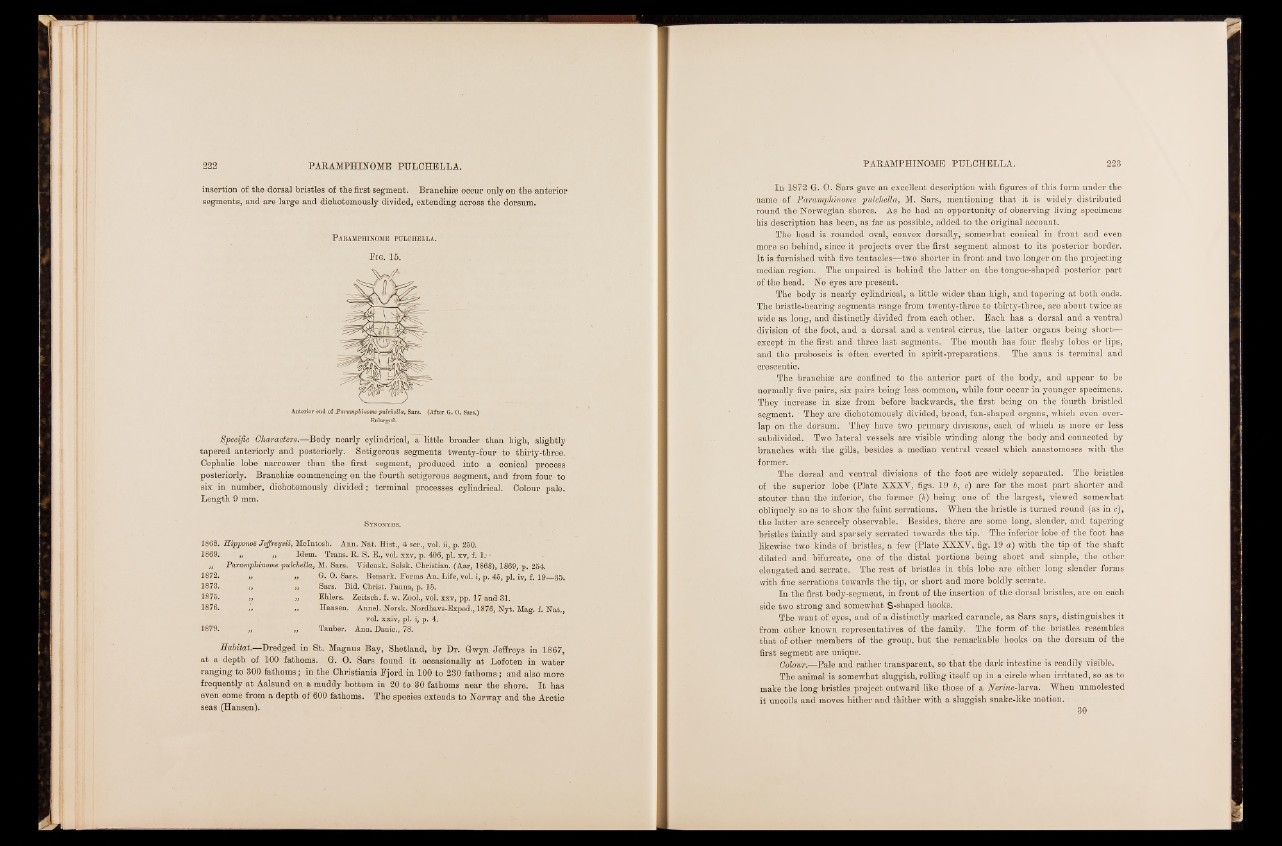
insertion of the dorsal bristles of the first segment. Branchise occur only on the anterior
segments, and are large and dichotomously divided, extending across the dorsum.
P a BAMPHINOME PULOHEIjLA.
Fig. 15. '
Anterior end of Paramphinome pulchella, Sars. (After G. 0 . Sars.)
Enlarged.
Specific Characters.—Body nearly cylindrical, a little broader than high, slightly
tapered anteriorly and posteriorly. Setigerous segments twenty-four to thirty-three.
Cephalic lobe narrower than the first segment, produced into a conical process
posteriorly. Branchiae commencing on the fourth setigerous segment, and from four to
six in number, dichotomously divided; terminal processes cylindrical. Colour pale.
Length 9 mm.
S yno nyms.
1868. Hvpponoë JeffreysU, Mclntosb. Ann. Nat. Hist., 4 ser., vol. ii, p. 250.
1869. „ ,, Idem. Trans. R. S. E., vol. xxv, p. 406, pl. xv, f. 1.' *
„ Paramphinome pulchella, M. Sars. Vidensk. Selsk. Christian. (Aar, 1868), 1869, p. 254.
1872. „ „ G. O. Sars. Remark. Forms An., Life, vol. i, p. 45, pl. iv, f. 19—35.
1873. „ „ Sars. Bid. Christ. Fauna, p. 15.
1875. „ ,, Ehlers. Zeitsch. f. w. Zool., vol. xxv, pp. 17 and 31.
1876. ;, ,, Hansen. Anne). Norsk. Nordhavs-Exped., 1876, Nyt. Mag.
vol. xxiv, pl. i, p. 4.
f. Nat.,
1879. i . „ Tauber. Ann. Danic., 78.
Habitat.—Dredged in St. Magnus Bay, Shetland, by Dr. G-wyn Jeffreys in 1867,
at a depth of 100 fathoms. G. O. Sars found it occasionally at Lofoten in water
ranging to 800 fathoms; in the Christiania Fjord in 100 to 230 fathoms ; and also more
frequently at Aalsund on a muddy bottom in 20 to 30 fathoms near the shore. I t has
even come from a depth of 600 fathoms. The species extends to Norway and the Arctic
seas (Hansen).
In 1872 G. O. Sars gave an excellent description with figures of this form under the
name of Paramphinome pulchella, M. Sars, mentioning that it is widely distributed
round the Norwegian shores. As he had an opportunity of observing living specimens
his description has been, as far as possible, added to the original account.
The. head is rounded oval, convex dorsally, somewhat conical in front and éven
more so behind, since it projects over the first segment almost to its posterior border.
I t is furnished with five tentacles—two shorter in front and two longer on the projecting
median region. The unpaired is behind the latter on the tongue-shaped posterior part
of the head. No eyes are présent.
The body is nearly cylindrical, a little wider than high, and tapering at both ends.
The bristle-bearing segments range from twenty-three to thirty-three, are about twice as
wide as long, and distinctly divided from each other. Each has a dorsal and a ventral
division of the foot, and a dorsal and a ventral cirrus, the latter organs being short—
except in the first and three last segments. The mouth has four fleshy lobes or lips,
and the proboscis is often everted in spirit-preparations. The anus is terminal and
crescentic.
The branchiae are confined to the anterior part of the body, and appear to be
normally five pairs, six pairs being less common, while four occur in younger specimens.
They increase in size from before backwards, the first being on the fourth bristled
segment. - They, are dichotomously divided, broad, fan-shaped organs, which even overlap
on the dorsum. They have two primary divisions, each of which is more or less
subdivided. Two lateral vessels are visible winding along the body and connected by
branches with the gills, besides a median ventral vessel which anastomoses with rfhe
former.
The dorsal and ventral divisions of the foot are widely separated. The bristles
of the superior lobe (Plate XXXY, figs. 19 b, c) are for the most part shorter and
stouter than the inferior, the former (&) being one of the largest, viewed somewhat
obliquely so as to show the faint serrations. When the bristle is turned round (as in c),
the latter are scarcely observable. Besides, there are some long, slender, and tapering
bristles faintly and sparsely serrated towards the tip. The inferior lobe of the foot has
likewise two kinds of bristles, a few (Plate XXXV, fig. 19 a) with the tip of the shaft
dilated and bifurcate, one of the distal portions being short and simple, the other
elongated and serrate. The rest of bristles in this lobe are eitherf||ng slender forms
with fine serrations towards the tip, or short and more boldly serrate.
In the first body-segment, in front of the insertion of the dorsal bristles, are on each
side two strong and somewhat S-shaped hooks.
The want of eyes, and of a distinctly marked caruncle, as Sars says, distinguishes it
from other known representatives of the family. The form of the bristles resembles
that of other members of the group, but the remarkable hooks on the dorsum of the
first segment are unique.
Colour.—Pale and rather transparent, so that the dark intestine is readily visible.
The animal is somewhat sluggish, rolling itself up in a circle when irritated, so as to
make the long bristles project outward like those of a Nerine-larva. When unmolested
it uncoils and moves hither and .thither with a sluggish snake-like motion.